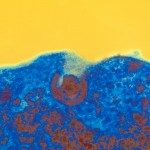Lien vers Pubmed [PMID] – 20419158
PLoS Pathog. 2010 Apr;6(4):e1000862
Early stages of Human Immunodeficiency Virus-1 (HIV-1) infection are associated with local recruitment and activation of important effectors of innate immunity, i.e. natural killer (NK) cells and dendritic cells (DCs). Immature DCs (iDCs) capture HIV-1 through specific receptors and can disseminate the infection to lymphoid tissues following their migration, which is associated to a maturation process. This process is dependent on NK cells, whose role is to keep in check the quality and the quantity of DCs undergoing maturation. If DC maturation is inappropriate, NK cells will kill them (“editing process”) at sites of tissue inflammation, thus optimizing the adaptive immunity. In the context of a viral infection, NK-dependent killing of infected-DCs is a crucial event required for early elimination of infected target cells. Here, we report that NK-mediated editing of iDCs is impaired if DCs are infected with HIV-1. We first addressed the question of the mechanisms involved in iDC editing, and we show that cognate NK-iDC interaction triggers apoptosis via the TNF-related apoptosis-inducing ligand (TRAIL)-Death Receptor 4 (DR4) pathway and not via the perforin pathway. Nevertheless, once infected with HIV-1, DC(HIV) become resistant to NK-induced TRAIL-mediated apoptosis. This resistance occurs despite normal amounts of TRAIL released by NK cells and comparable DR4 expression on DC(HIV). The escape of DC(HIV) from NK killing is due to the upregulation of two anti-apoptotic molecules, the cellular-Flice like inhibitory protein (c-FLIP) and the cellular inhibitor of apoptosis 2 (c-IAP2), induced by NK-DC(HIV) cognate interaction. High-mobility group box 1 (HMGB1), an alarmin and a key mediator of NK-DC cross-talk, was found to play a pivotal role in NK-dependent upregulation of c-FLIP and c-IAP2 in DC(HIV). Finally, we demonstrate that restoration of DC(HIV) susceptibility to NK-induced TRAIL killing can be obtained either by silencing c-FLIP and c-IAP2 by specific siRNA, or by inhibiting HMGB1 with blocking antibodies or glycyrrhizin, arguing for a key role of HMGB1 in TRAIL resistance and DC(HIV) survival. These findings provide evidence for a new strategy developed by HIV to escape immune attack, they challenge the question of the involvement of HMGB1 in the establishment of viral reservoirs in DCs, and they identify potential therapeutic targets to eliminate infected DCs.




